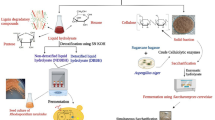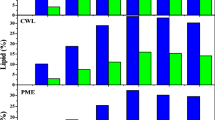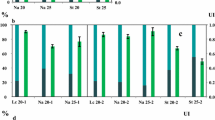Abstract
Recent research has focused on use of waste agro- residues for growth of oleaginous microbial biomass as renewable feedstock for biodiesel. However, pretreatment of lignocellulosic biomass into fermentable sugar is necessary for microbial growth, increasing production costs. An oleaginous fungal isolate from the tropical mangrove wetlands, IBB G4, identified as Aspergillus candidus was assessed for its growth on waste agro-residues viz., banana peel, copra meal, corn cob, grape stalks and sugarcane bagasse,which had not been given any thermo-chemical or enzymatic pre-treatment. The resulting fungal biomass was subjected to in situ (direct) acid transesterification for fatty acid methyl esters (FAME) extraction. Maximal FAME production was obtained on raw untreated banana peel (420 mg/L) and sugarcane bagasse (400 mg/L) with the yields significantly higher (52–68 mg/g of fermented biomass) than those for glucose (32 mg/g). The FAMEs showed major presence of monounsaturated methyl esters (41.7 %; C18:1, C15:1, C17:1, C14:1) and methyl linoleate (C18:2, 36.8 %) and 20 % as saturated fraction when sugarcane bagasse was the substrate for fungal strain. For banana peel, the saturated fatty acid methyl esters (48.6 %; C16:0, C18:0) were abundant, methyl oleate (C18:1, 25 %) was the major monounsaturated fatty ester while methyl linoleate (C18:2, 19 %) and methyl arachidonate (C20:4, 3.8 %) were prevalent as polyunsaturated methyl esters. Biodiesel fuel properties (density, kinematic viscosity, iodine value, cetane number, free and total glycerol) were in accordance with international(ASTM D6751, EN 14214) and national (IS 15607) biodiesel standards, suggesting their suitability as biodiesel fuel.The results in our study indicate the potential suitability of A. candidus IBBG4 biomass grown on raw untreated banana peel and sugarcane bagasse waste and its conversion to FAME by direct in situ acid transesterification. This would help improve process economics for a green and sustainable production of biodiesel.



Similar content being viewed by others
References
REN 21’s Renewables 2014, Global Status Report; www.ren21.net.Accessed 5 Jan 2015
Nascimento IA, Marques SSI, Cabanelas ITD et al (2013) Screening microalgae strains for biodiesel production: lipid productivity and estimation of fuel quality based on fatty-acids profiles as selective criteria. Bioenerg Res 6:1–13
Meeuwse P, Sanders JPM, Tramper J, Rinzema A (2013) Lipids from yeasts and fungi: Tomorrow’s source of biodiesel? Biofuels Bioprod Biorefin 7:512–524
Zheng Y, Yu X, Zeng J, Chen S et al (2012) Feasibility of filamentous fungi for biofuel production using hydrolysate from dilute sulfuric acid pretreatment of wheat straw. Biotechnol Biofuels 5:50
Yousuf A (2012) Biodiesel from lignocellulosic biomass — Prospects and challenges. Waste Manag 32:2061–2067
Huang C, Chen X, Xiong L et al (2012) Single cell oil production from low-cost substrates: The possibility and potential of its industrialization. Biotechnol Adv 31:129–139
Yang SJ, Kataeva I, Hamilton-Brehm SD et al (2009) Efficient degradation of lignocellulosic plant biomass, without pretreatment, by the thermophilic anaerobe “Anaerocellumthermophilum” DSM 6725. Appl Environ Microbiol 75:4762–4769
Linger JG, Darzins A (2013) Consolidated bioprocessing. In: Lee JW (ed) Advanced biofuels and bioproducts. Springer Science + Business Media, New York, pp 267–280
Khot M, Kamat S, Zinjarde S et al (2012) Single cell oil of oleaginous fungi from the tropical mangrove wetlands as a potential feedstock for biodiesel. Microb Cell Factories 11:71
Liu B, Zhao Z (2007) Biodiesel production by direct methanolysis of oleaginous microbial biomass. J Chem Technol Biotechnol 82:775–780
Vicente G, Bautista LF, Gutierrez FJ et al (2010) Direct transformation of fungal biomass from submerged cultures into biodiesel. Energy Fuel 24:3173–3178
Lewis T, Nicholas PD, McMeekin TA (2000) Evaluation of extraction methods for recovery of fatty acids from lipid producing micro-heterotrophs. J Microbiol Methods 43:107–116
Subhash VG, Mohan VS (2011) Biodiesel production from isolated oleaginous fungi Aspergillus sp. using corncob waste liquor as a substrate. Bioresour Technol 102:9286–9290
Alcantara R, Amores J, Canoira L et al (2000) Catalytic production of biodiesel from soybean oil, used frying oil and tallow. Biomass Bioenergy 18:515–527
Al-Widyan MI, Al-Shyoukh AO (2002) Experimental evaluation of the transesterification of waste palm oil into biodiesel. Bioresour Technol 85:253–256
Mondala A, Liang K, Toghiani H et al (2009) Biodiesel production by in situ transesterification of municipal primary and secondary sludges. Bioresour Technol 100:1203–1210
Wahlen BD, Willis MR, Seefeldt LC et al (2011) Biodiesel production by simultaneous extraction and conversion of total lipids from microalgae, cyanobacteria and wild mixed-cultures. Bioresour Technol 102:2724–2730
Johnson MB, Wen Z (2009) Production of biodiesel fuel from the microalgaSchizochytriumlimacinum by direct transesterification of algal biomass. Energy Fuel 23:5179–5183
Suutari M, Priha P, Laakso S (1993) Temperature shifts in regulation of lipids accumulated by Lipomycesstarkeyi. J Am Oil Chem Soc 70:891–894
Klich MA (2002) Identification of common Aspergillus species. Centraalbureau voor Schimmelcultures, Utrecht
Varga J, Frisvad JC, Samson RA (2007) Polyphasic taxonomy ofAspergillussectionCandidibased on molecular, morphological and physiological data. Stud Mycol 59:75–88
Stahl PD, Klug MJ (1996) Characterization and differentiation of filamentous fungi based on fatty acid composition. Appl Environ Microbiol 62:4136–4146
Fraga ME, Santana DMN, Gatti MJ et al (2008) Characterization of Aspergillus species based on fatty acid profiles. Mem Inst Oswaldo Cruz 103(6):540–544
Knothe GH (2005) Dependence of biodiesel fuel properties on the structure of fatty acid alkyl esters. Fuel Process Technol 86:1059–1070
Pratas MJ, Freitas Samuel VD, Oliveira MB et al (2011) Biodiesel density: experimental measurements and prediction models. Energy Fuel 25:2333–2340
Lapuerta M, Rodriguez-Fernandez J, Armas O (2010) Correlation for the estimation of the density of fatty acid esters fuels and its implications, a proposed biodiesel cetane index. Chem Phys Lipids 163:720–727
Knothe G, Steidley KR (2011) Kinematic viscosity of fatty acid methyl esters: prediction, calculated viscosity contribution of esters with unavailable data, and carbon–oxygen equivalents. Fuel 90:3217–3224
Ramírez-Verduzco LF, Rodríguez-Rodríguez JE, Jaramillo-Jacob ADR (2012) Predicting cetane number, kinematic viscosity, density and higher heating value of biodiesel from its fatty acid methyl ester composition. Fuel 91:102–111
Azam MM, Waris A, Nahar NM (2005) Prospects and potential of fatty acid methyl esters of some non-traditional seed oils for use as biodiesel in India. Biomass Bioenergy 29:293–302
Gunstone FD, Harwood JL, Dijkstra AJ (2007) The Lipid Handbook. CRC Press, Boca Raton
Demirbas A (1998) Fuel properties and calculation of higher heating values of vegetable oils. Fuel 77:1117–1120
Ramos MJ, Fernández CM, Casas A et al (2009) Influence of fatty acid composition of raw materials on biodiesel properties. Bioresour Technol 100:261–268
Soares AT, Dayane CC, Silva BF (2014) Comparative analysis of the fatty acid composition of microalgae obtained by different oil extraction methods and direct biomass transesterification. Bioenerg Res 7(3):1035–1044
Amaretti A, Raimondi S, Sala M et al (2010) Single cell oils of the cold-adapted oleaginous yeast Rhodotorulaglacialis DBVPG 4785. Microb Cell Factories 9:73
Olson DG, McBride JE, Shaw AJ, Lynd LR (2012) Recent progress in consolidated bioprocessing. Curr Opin Biotechnol 23(3):396–405
PandeyA SCR, Nigam P, Soccol VT (2000) Biotechnological potential of agro-industrial residues. I: Sugarcane bagasse. Bioresour Technol 74:69–80
Santa-Maria M, Ruiz-Colorado AA, Cruz G (2013) Assessing the feasibility of biofuels production from lignocellulosicbanana waste in rural agricultural communities in Peru and Colombia. Bioenerg Res 6:1000–1011
Thliveros P, UckunKiran E, Webb C (2014) Microbial biodiesel production by direct methanolysis of oleaginous biomass. Bioresour Technol 157:181–187
Cheirsilp B, Louhasakul Y (2013) Industrial wastes as a promising renewable source for production of microbial lipid and direct transesterification of the lipid into biodiesel. Bioresour Technol 142:329–337
Ratledge C (1989) Biotechnology of oils and fats. In: Ratledge C, Wilkinson SG (eds) Microbial Lipids, volume 2. Academic Press, London, pp 567–668
Subramaniam R, Dufreche S, Zappi M, Bajpai R (2010) Microbial lipids from renewable resources: production and characterization. J Ind Microbiol Biotechnol 37:1271–1287
Katre G, Joshi C, Khot M et al (2012) Evaluation of single cell oil (SCO) from tropical marine yeast Yarrowialipolytica NICM 3589 as a potential feedstock for biodiesel. AMB Express 2:36
Raper KB, Fennell DI (1965) The genus Aspergillus. Williams & Wilkins, Baltimore
Nemec T, Jernec K, Cimerman A (1997) Sterols and fatty acids of different Aspergillus species. FEMS Microbiol Lett 149:201–205
Wilson RA, Calvo AM, Chang PK, Keller NP (2004) Characterization of the Aspergillusparasiticus ∆12-desaturase gene: a role for lipid metabolism in the Aspergillus-seed interaction. Microbiology 150:2881–2888
Wynn JP, Ratledge C (1997) Malic enzyme is a major source of NADPH for lipid accumulation by Aspergillus nidulans. Microbiology 143:253–257
Knothe G (2008) “Designer” Biodiesel: optimizing fatty ester composition to improve fuel properties. Energy Fuel 22:1358–1364
NREL (2009) Biodiesel handling and use guide. National Renewable Energy Laboratory, U.S.Department of Energy. http://www.nrel.gov/vehiclesandfuels/pdfs/43672.pdf. Accessed 17 June 2014
Moser BR, Vaughn SF (2012) Efficacy of fatty acid profile as a tool for screening feedstocks for biodiesel production. Biomass Bioenergy 37:31–41
Acknowledgments
The authors thank IBB Institutional Research Fund (DRDP) and DST Purse, Savitribai Phule Pune University, Pune for financial support.
Conflict of Interest
The authors declare that they have no conflict of interest.
Author information
Authors and Affiliations
Corresponding author
Rights and permissions
About this article
Cite this article
Kakkad, H., Khot, M., Zinjarde, S. et al. Biodiesel Production by Direct In Situ Transesterification of an Oleaginous Tropical Mangrove Fungus Grown on Untreated Agro-Residues and Evaluation of Its Fuel Properties. Bioenerg. Res. 8, 1788–1799 (2015). https://doi.org/10.1007/s12155-015-9626-x
Published:
Issue Date:
DOI: https://doi.org/10.1007/s12155-015-9626-x




